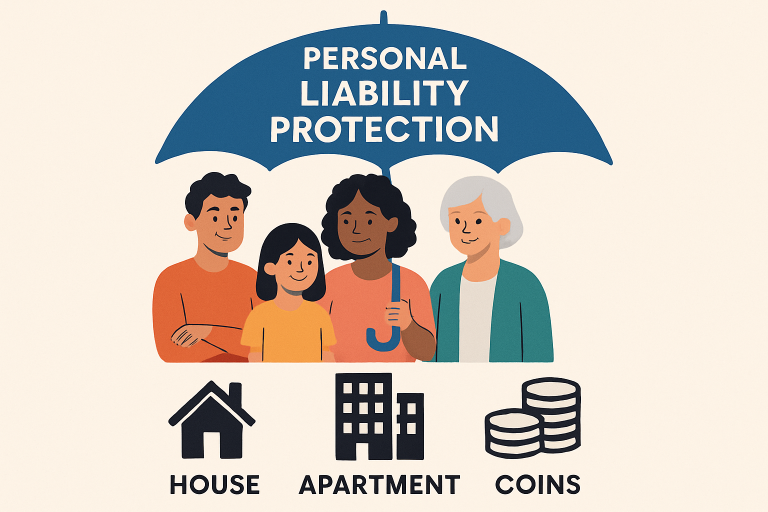Personal liability insurance is often misunderstood, leading many people to overlook its value or confuse its scope of protection. Usually, there’s a perception that personal liability coverage is a luxury reserved for high-net-worth individuals with significant assets at stake. However, nothing could be further from the truth. Personal liability insurance is a cornerstone of sound financial planning for individuals at any stage of life and from all walks of life. A sudden accident or mishap can happen to anyone, and the costs resulting from legal action can be devastating. AARP-backed personal liability protection options demonstrate that this vital safeguard is both accessible and affordable for the average policyholder. Whether you own a home, rent an apartment, or are simply looking to enhance your financial security, personal liability insurance provides a safety net to fall back on when life throws the unexpected.
Misinformation around personal liability insurance can leave you perilously exposed to risks that you might not have anticipated. Acting on myths rather than facts means you could be underinsured—assuming you’re covered for situations you’re not, overlooking important policy details, or even skipping coverage entirely. Understanding the reality behind personal liability insurance empowers you to protect what matters most and gives you the peace of mind that comes with making informed decisions. Whether you’re a homeowner, renter, or simply someone who recognizes that accidents happen, being knowledgeable about personal liability coverage ensures you aren’t caught off guard in the face of life’s unpredictabilities.
Myth 1: Personal Liability Insurance Is Only for the Wealthy
One of the most prevalent myths is that personal liability coverage is a necessity only for the wealthy. This belief typically stems from the notion that only individuals with substantial assets are at risk of being sued for large sums. However, the reality is that anyone can find themselves facing a costly lawsuit, regardless of their net worth. Everyday occurrences—such as a neighbor’s child being injured while playing in your yard, a dog bite incident, or a slip and fall on your property—can lead to claims for medical expenses, legal fees, and lost wages that quickly balloon into thousands or even hundreds of thousands of dollars. Without personal liability coverage, even those who do not own a home or have significant wealth can find their savings depleted or their future earnings at risk through wage garnishments or court-ordered payments. Everyone, regardless of their financial status, needs this essential protection so one unexpected mishap does not upend their lives.
Myth 2: My Homeowners or Renters Insurance Covers All Liability
Many people assume that their standard homeowners or renters insurance provides blanket liability protection. While these policies do typically include a degree of personal liability coverage, the protection they offer is often limited in scope and value. Standard coverage caps can be quickly exhausted if you’re faced with a major lawsuit, leaving you responsible for any costs beyond the policy limit. In addition, certain situations—such as claims of libel or slander, or injuries caused by specific breeds of pets—may not be covered by a basic policy at all. There are also exclusions for business-related incidents, intentional acts, and certain accidents away from home. To ensure you are adequately protected, it’s vital to read your policy’s fine print carefully and understand exactly what it covers. It isn’t covered, and consider supplementing your coverage with an umbrella policy or additional riders. According to NerdWallet’s guide to personal liability insurance, opting for extra protection is a practical way to avoid the potentially catastrophic financial consequences of coverage gaps.
Myth 3: Personal Liability Insurance Is Too Expensive
Affordability concerns often lead people to forego the added security of personal liability insurance. However, this perceived barrier is far from the truth. Personal liability coverage is surprisingly affordable, especially when compared to the high costs incurred from even a single lawsuit or accident. The typical annual premium is a small fraction of what you might pay in legal fees, medical bills, or damages if you’re held liable in an accident. Insurance providers offer a range of customizable options, allowing you to select the amount of coverage that fits your budget and risk tolerance. By allocating a modest amount each year, you protect yourself from the financial devastation that could result from an unfortunate event—even one that seems minor at first. Think of personal liability insurance as an investment in your future peace of mind: it’s an economical way to guard against life’s uncertainties.
Myth 4: Only Homeowners Need Personal Liability Insurance
There’s a widespread misconception that only homeowners require personal liability coverage, since they own property which could be the scene of an accident. This myth overlooks the reality that renters also face liability risks in daily life. If someone suffers an injury in your rented apartment, or if you accidentally damage a neighbor’s property (for example, by leaving a faucet running and causing water damage), you may be held legally responsible—sometimes for substantial sums. Renters’ personal liability insurance steps in to help with legal fees, settlement costs, and medical expenses arising from such incidents. And often, coverage is not limited to your home; it can extend to injuries or accidental harm you may cause elsewhere. For renters, personal liability insurance is a smart and affordable investment that helps preserve your financial stability and ensures unexpected accidents or claims do not financially derail you. No matter your living situation, this coverage is a practical way to protect yourself and your future.
Myth 5: Personal Liability Insurance Covers All Types of Incidents
A common misconception is that personal liability insurance is a catch-all for any accident or lawsuit. In reality, every policy comes with its own set of terms, exclusions, and limitations. Typically, personal liability insurance is designed to cover third-party bodily injury and property damage caused by negligence. It does not extend to claims involving intentional harm, business operations, professional services, certain high-risk activities or hobbies (such as running a business from home or competitive sports), or anything deemed outside the policy’s scope. To ensure comprehensive protection, it’s crucial to read your policy closely, ask your agent about potential gaps, and keep yourself updated if your circumstances change—such as starting a business or adopting a pet with higher liability risks. By understanding where liability insurance ends and when other types of coverage may be needed, you can avoid the unpleasant surprise of finding out too late that you’re not protected as you thought.
Final Thoughts
Dispelling common myths about personal liability insurance is crucial for effective financial planning and peace of mind. This essential coverage helps keep you, your family, and your assets protected from the unpredictable events life can throw your way. The truth is, personal liability insurance is accessible, affordable, and relevant for everyone—regardless of wealth or homeownership status. Take the time to thoroughly evaluate your risks, review your existing coverage, and consult with a trusted insurance expert to ensure your policy aligns with your lifestyle and needs. It’s not the size of your bank account, but the act of preparation that counts most when safeguarding your finances from unanticipated accidents or lawsuits.
For more comprehensive and budget-friendly coverage information, be sure to explore AARP-backed personal liability protection, as well as authoritative resources such as the NerdWallet personal liability insurance guide. Making the right choices today means ensuring a more secure and confident tomorrow.

